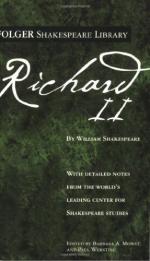|
This section contains 10,756 words (approx. 36 pages at 300 words per page) |

|
SOURCE: Falco, Raphael. “Charismas in Conflict: Richard II and Henry Bolingbroke.” Exemplaria 11, no. 2 (1999): 473-502.
In the following essay, Falco focuses on the concept of charisma in his comparative analysis of Richard II and Henry Bolingbroke.
Shakespeare's Richard II is an anatomy of charismas in conflict. Pure personal charisma, lineage or dynastic charisma, and several kinds of office charisma—to use Max Weber's terms—confront each other throughout the play. These different stages of charismatic authority, according to the Weberian model, reflect a progression (or regression) from revolutionary personal leadership to increased rationalization and finally bureaucratization. Weber maintained that all the modifications of personal charisma have basically the same cause: “[t]he desire to transform charisma and charismatic blessing from a unique, transitory gift of grace of extraordinary times and persons to a permanent possession of everyday life.”1 The transformations of charismatic authority inevitably result in conflicts since the...
|
This section contains 10,756 words (approx. 36 pages at 300 words per page) |

|


